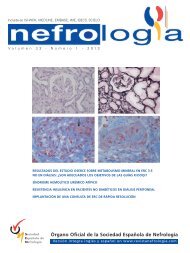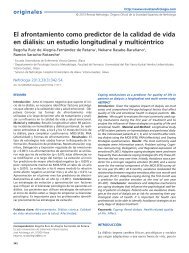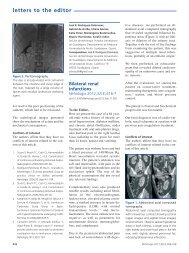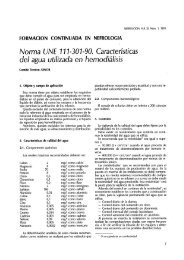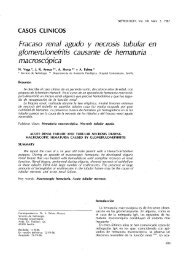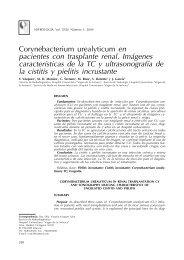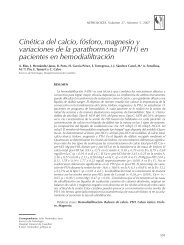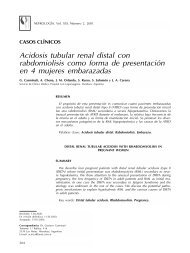PDF Número - NefrologÃa
PDF Número - NefrologÃa
PDF Número - NefrologÃa
Create successful ePaper yourself
Turn your PDF publications into a flip-book with our unique Google optimized e-Paper software.
Marcin Adamczak et al. Ischemic nephropathy<br />
revisión corta<br />
The progressive kidney fibrosis may occur also through the<br />
other mechanisms of tissue and vascular injury -<br />
aldosterone–mediated damage, sympathetic overactivity and<br />
increased release of reactive oxygen species (ROS).<br />
Ang II stimulates the production of ROS. Lerman et al.<br />
demonstrated increased oxidative stress in pig model of RAS<br />
and Higashi et al. and Minuz et al. in patients with RAS. 41-43<br />
ROS increases renal vascular tone, sensitivity to<br />
vasoconstrictors and leads to endothelial dysfunction. 44 The<br />
interaction of ROS with nitric oxide (NO) decreases<br />
bioavailability of the latter and results in formation of the<br />
prooxidant peroxynitrite. Reduction of NO activity allows<br />
vasopressors like angiotensin II and endothelin-1 (ET-1) to<br />
dominate and to lead to vasoconstriction and as a<br />
consequence to GFR decrease.<br />
Ischemic nephropathy is characterized by the endothelial<br />
disfunction. The importance of the endothelial damage in ischemic<br />
nephropathy was demonstrated in an experimental porcine model. A<br />
single intrarenal infusion of autologous endothelial progenitor cells<br />
(EPC) preserves microvascular architecture and function and<br />
decreases microvascular remodeling. 45<br />
CLINICAL PICTURE AND DIAGNOSIS<br />
The clinical presentation of patients likely to develop<br />
ischemic nephropathy consist of: older age (over 50 years),<br />
hypertension (usually severe or difficult to treat), history of<br />
smoking, hypercholesterolemia, coronary heart disease or<br />
the other clinical manifestation of atherosclerosis. Such a<br />
patient has gradually decreasing GFR, mild to moderate<br />
proteinuria and bland urinary sediment. Loss of GFR, as in<br />
the other nephropathies, may be an useful parameter for<br />
progression of ischemic nephropathy.<br />
Proteinuria may also be recognized as a marker of severity<br />
of ischemic nephropathy. Makanjuola et al. surveyed 94<br />
patients with atherosclerotic RAS. Fifty two percent of the<br />
patients had proteinuria. In patients with GFR >_50ml/min<br />
mean urinary protein excretion was 400mg/24h, and in<br />
patients with GFR _70%, may predict that stenosis<br />
itself is hemodynamically important and influences the<br />
blood kidney supply and give a hope for reversibility of<br />
the interstitial and glomerular lesions.<br />
It should be stressed that none of the above mentioned<br />
methods was validated in the properly controlled clinical<br />
studies. All of this tests are to some extend inadequate in<br />
predicting which patient with ischemic nephropathy will<br />
benefit from revascularization. Because of clinical<br />
435



